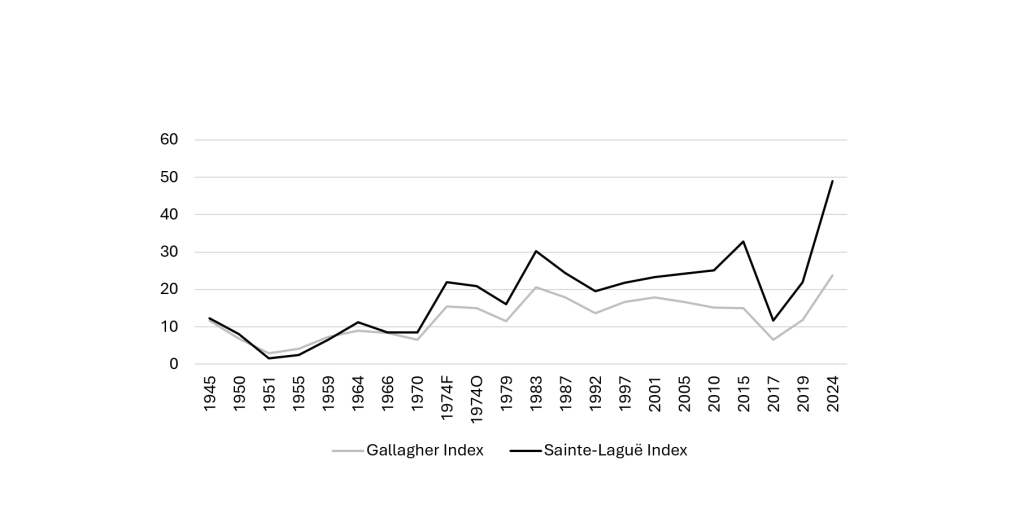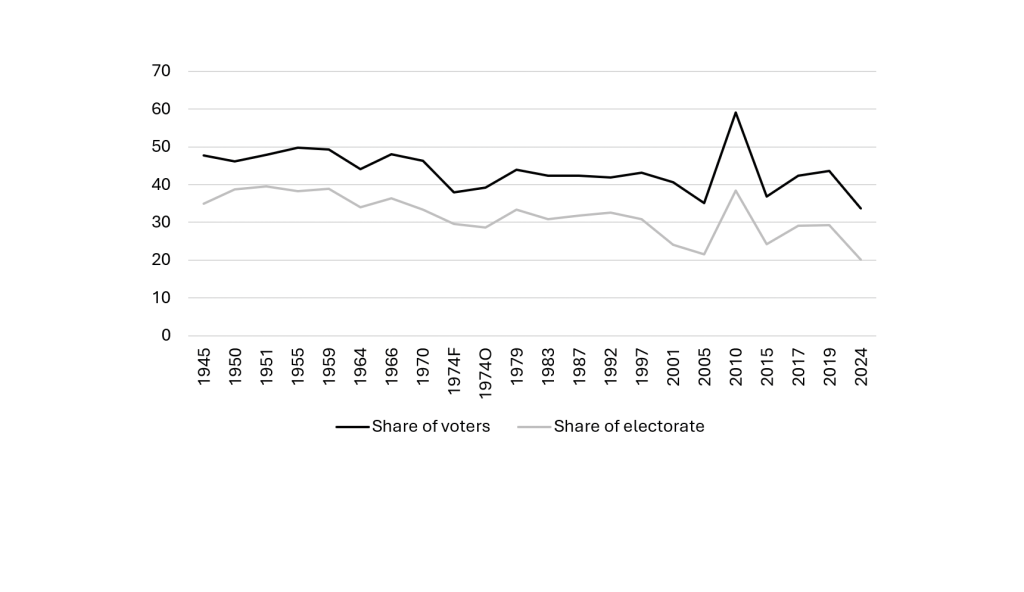
Prof Alan Renwick
Professor of Democratic Politics and Deputy Director of the Constitution Unit, in the UCL Department of Political Science. His research examines the formal mechanisms through which citizens’ voices are heard in politics, including elections, referendums, and deliberative processes such as citizens’ assemblies.
Email: a.renwick@ucl.ac.uk

UK Election 2024
Section 1: Democracy and representation
1. Public anxiety and the electoral process (Prof Barry Richards)
2. How Nigel Farage opened the door to No. 10 for Keir Starmer (Prof Pippa Norris)
3. The performance of the electoral system (Prof Alan Renwick)
4. Tory downfall is democracy rectifying its mistakes (Prof Stephen Barber)
5. Votes at 16 and decent citizenship education could create a politically aware generation (Dr Ben Kisby, Dr Lee Jerome)
6. “An election about us but not for us”: the lack of communication for young people during GE2024 (Dr James Dennis)
7. Election timing: masterstroke or risky gamble? (Prof Sarah Birch)
8. The dog that didn’t bark? Electoral integrity and administration from voter ID to postal votes (Prof Alistair Clark)
9. A political gamble? How licit and illicit betting permeated the campaign (Dr Matthew Wall)
10. Ethnic diversity in politics is the new normal in Britain (Prof Maria Sobolewska)
11. Bullshit and Lies on the campaign trail: do party campaigns reflect the post-truth age? (Prof Darren Lilleker)
12. Stoking the culture wars: the risks of a more hostile form of polarised politics (Dr Jen Birks)
At least at first sight, the election result perfectly illustrates the cases both for and against the First Past the Post electoral system.
The greatest benefit of that system – at least according to its advocates – is that it allows the voters, rather than post-election negotiations between political parties, to decide who will govern. It does this by, typically, giving a single party a majority of parliamentary seats, so voters can throw out a government they dislike and install another. In fact, such clean transitions are rarer than the system’s cheerleaders would have us believe: only once before since 1945 – in 1970 – had a secure governing majority for one party been replaced by a secure governing majority for another. But the 2024 election delivered the most decisive transition of the post-Second World War era: a Conservative government originally elected with a majority of 80 was replaced by a Labour government with a majority of 172.
First Past the Post’s critics, meanwhile, focus primarily on the disproportionality of the results that it generates. Parliament is supposed to represent the nation. It cannot adequately do that if the seat shares of the various political parties are markedly out of kilter with those parties’ shares of the votes cast. Exactly how electoral disproportionality should be measured is debated. By any reasonable measure, however, the 2024 election was – by a long stretch – the most disproportional since 1945. Figure 1 shows two such measures. The Gallagher index is the most widely used, while the Sainte Laguë index, I have argued previously, better captures the underlying concept.

Figure 1. Disproportionality at UK General Elections since 1945
The major factor in that pattern was the over-representation of the Labour Party, which secured 63.4% of the seats on just 33.7% of the votes. In absolute terms, this was the largest over-representation for any party in postwar history; it was also the most favourable ratio of votes to seats obtained by either of the main parties over the same period. Reform UK and, to a lesser extent, the Conservatives were meanwhile under-represented. For once, the Liberal Democrats secured almost their proportional seat share.
The arguments both for and against reform of the First Past the Post system thus seem to be strengthened by the result. But we have looked so far only at the headlines. If we scratch further beneath the surface, the election also illustrates those arguments’ weaknesses.
As regards the case for First Past the Post, there is clearly a difficulty in saying that the result illustrates voter control over government formation when the winning party secured only a fraction more than a third of the votes cast. Indeed, when we also take account of turnout – which, at 59.7%, was only fractionally above the post-1945 low reached in 2001 – Labour’s claim to a governing mandate is, as Figure 2 shows, weaker still. Just 20.1% of eligible electors cast a ballot in Labour’s favour, beating the previous post-1945 record of 21.6% reached in 2005.

Figure 2. Vote share of the party/parties forming the government, since 1945
Turning to the pro-reform argument, the claim that seat shares ought to equal vote shares asks us to assume that there are discrete viewpoints in the electorate that the various parties represent, and that voters choose the party that is closest to them. Yet the 2024 election has illustrated perhaps better than any previous one that this picture is too simplistic. Many electors voted tactically, casting their ballot not for their first preference, but for a candidate they could tolerate who was better placed to defeat another. Furthermore, several parties – particularly Labour, the Liberal Democrats, and the Greens – ran very effective targeted campaigns, further skewing the results. We cannot read off from the overall vote totals what the parties’ seat shares in a ‘fair’ contest ought to have been.
In sum, supporters of electoral reform will see their case as strengthened by this election result, and will push hard for change; but advocates of the status quo will also find much to solidify their own view. Having secured a landslide majority, Labour’s leaders are hardly likely to seek change in the system that gave them victory. And, believing in the value of clear government accountability to voters and strong majorities, they may feel that they have right as well as self-interest on their side. At least in the short term, therefore, electoral reform seems highly unlikely.
Yet the longer term is less certain. The combined Labour and Conservative vote share, at 57.4%, was well below the previous post-war low of 65.1%, reached in 2010. This fits with a gradual, though jagged, trend towards greater party system fragmentation evident since the 1970s. Such fragmentation tends to make election results less predictable and single-party majorities harder to build, thereby weakening both the democratic case for First Past the Post and the large parties’ self-interest in maintaining it. Should such trends continue, therefore, electoral reform may rise up the agenda in the years to come.
